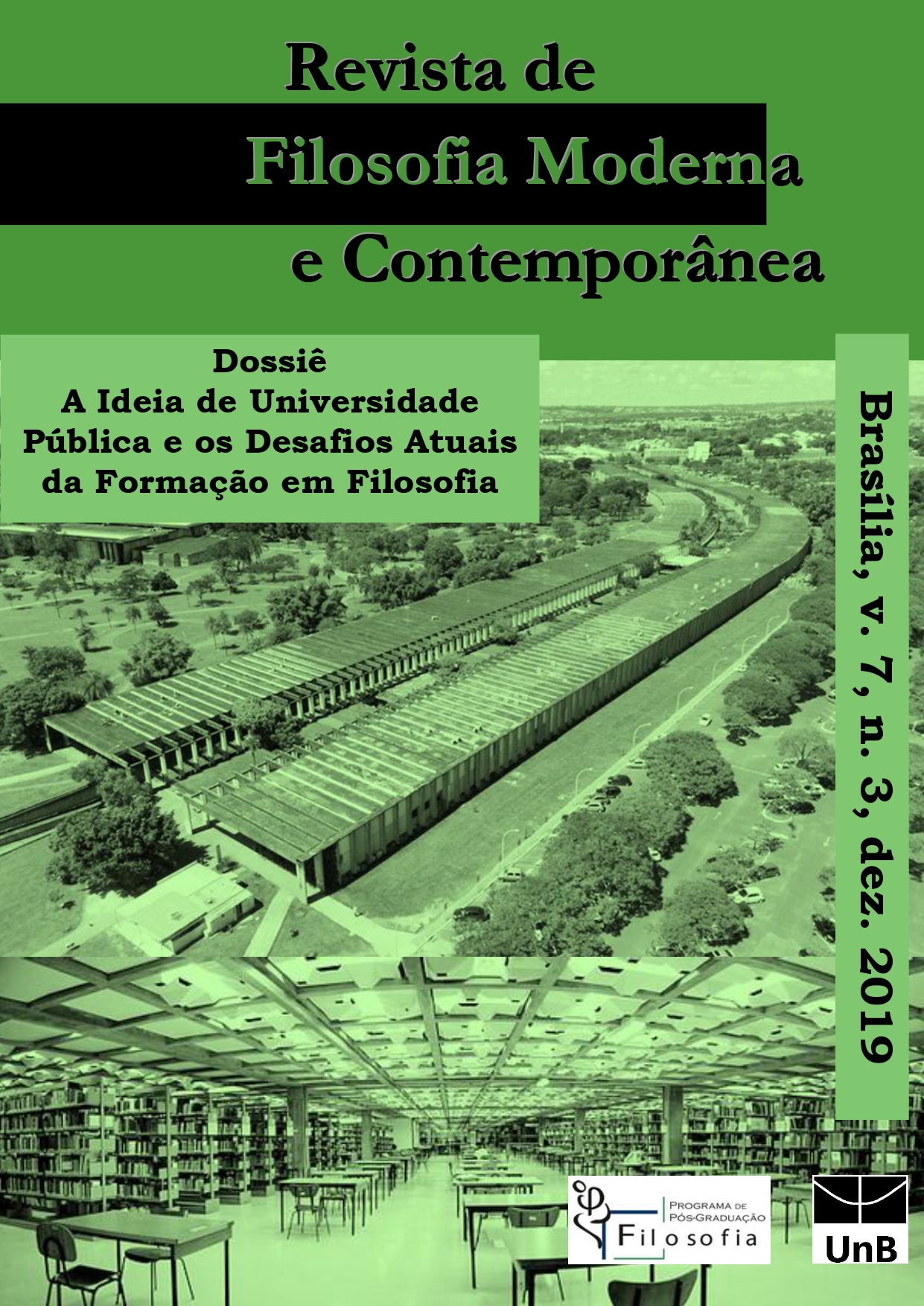Criatividade e Grafos Existenciais em C. S. Peirce
DOI:
https://doi.org/10.26512/rfmc.v7i3.28453Schlagworte:
lógica diagramática; dedução; criatividade; Charles S. Peirce; grafos existenciaisAbstract
O raciocínio lógico dedutivo é comumente definido como analítico e explicativo, no sentido em que nada acrescenta, em sua conclusão, além daquilo já contido nas premissas do argumento. Contudo, duas importantes conclusões da filosofia da lógica de Charles S. Peirce contestam essa suposta trivialidade do raciocínio dedutivo: (i) dedução é matéria de experimento e observação; e (ii) dedução é um tipo de raciocínio diagramático. O objetivo deste trabalho é mostrar com essas duas conclusões estão interligadas e como, juntas, podem elucidar aspectos criativos da lógica. Para isso, serão discutidas as seguintes teses. Primeiro, a prova dedutiva inclui uma etapa criativa (Peirce a chama de dedução teoremática) que explica como um raciocínio analítico pode, em alguns casos, ser surpreendente em suas conclusões. Segundo, sistemas formais que incluem representações diagramáticas, como os Grafos Existenciais, são mais eficientes em representar inferências dedutivas do tipo teoremáticas.
Downloads
Literaturhinweise
ANDERSON, Douglas R. Creativity and the philosophy of C. S. Peirce. Martinus Nijhoff Publishers: Dordrecht, 1987.
CAMPOS, Daniel G. The imagination and hyphotesis-making in mathematics: a peircean account. In: New essays on Peirce’s Mathematical Philosophy. MOORE, Matthew E. (ed.). Chicago and La Salle, Illinois: Open Court, 2010. p. 123-145.
EUCLIDES. Os elementos. Trad. e introd. Irineu Bicudo. São Paulo: UNESP, 2009.
FREGE, Gottlob (1879). Preface. In: Begriffsschrift, a formula language, modeled upon that of arithmetic, for pure thought. In: HEIJENOORT, Jean van. From Frege to Gödel: a source book in Mathematical Logic, 1879-1931. Cambridge, Mass.; London, England: Harvard University Press, 1967. p. 5-8.
HINTIKKA, Jaakko. Information, deduction, and the a priori. In: Logic, language-games and information. Kantian themes in the Philosophy of Logic. Oxford: Clarendon Press, 1973. p. 222-241.
______. C.S. Peirce “first real discovery” and its contemporary relevance. In: The relevance of Charles Peirce. FREEMAN, Eugene (ed.). La Salle, Illinois: The Hegeler Institute/ Monist Library of Philosophy, 1983. p. 107-118.
______. On creativity in reasoning. In: ANDERSSON, Ake E. and SAHLIN, Nils-Eric (eds.). The complexity of creativity. Dordrecht: Kluwer Academic Publishers, 1997. p. 67-78.
HOFFMAN, Michael. Peirce's "diagrammatic reasoning" as a solution of the learning paradox. In: Process pragmatism: essays on a quiet philosophical revolution. DEBROCK, Guy (ed.). Amsterdam/ New York: Rodopi B.V., 2003. p. 121-143.
______. “Theoric transformations” and a new classification of abductive inferences. Transactions of the Charles S. Peirce Society: a quarterly journal in American Philosophy, v. 46, n. 4, p. 570-590, 2010.
KETNER, Kenneth Laine. How Hintikka misunderstood Peirce’s account of theorematic reasoning. Transactions of the Charles Peirce Society: a quarterly journal in American Philosophy, vol. XXI, n. 3, p. 407-418, 1985.
LEVY, Stephen H. Peirce’s theoremic/ corollarial distinction and the interconnections between mathematics and logic. In: Studies in the logic of Charles Sanders Peirce. HOUSER, Nathan; ROBERTS, Don D.; and EVRA, James Van (eds.). Indianapolis: Indiana University Press, 1997, p. 85-110.
LISZKA, James Jakób. A general introduction to the semeiotic of Charles Sanders Peirce. Bloomington and Indianapolis: Indiana University Press, 1996.
PEIRCE, Charles Sanders. Collected Papers. 8 vols. HARTSHORNE, Charles; HEISS, Paul and BURKS, Arthur (eds.). Cambridge: Harvard University Press, 1931-1958. [Citado como CP, seguido do número do volume e do número do parágrafo.]
______. Essential Peirce. HOUSER, Nathan; KLOESEL, Christian (eds.). Vol. 1 (1867-1893). Bloomington: Indiana University Press, 1992. [Citado como EP 1, seguido do número da página.]
______. Essential Peirce. The PEIRCE Edition Project (eds.). Vol. 2 (1893-1913). Bloomington: Indiana University Press, 1998. [Citado como EP 1, seguido do número da página.]
______. Pragmatism as a principle and method of right thinking: the 1903 Harvard lectures on pragmatism. TURRISI, Patricia Ann (ed.). New York: State University of New York Press, 1997. [Citado como HLP, seguido do número da página.]
______. The new elements of mathematics by Charles S. Peirce. 4 vols. EISELE, Carolyn (ed.). Bloomington: Indiana University Press, 1976. [Citado como NEM seguido do volume e número da página.]
______. Philosophy of Mathematics: selected writings. MOORE, Matthew E. (ed.). Indiana University Press: Bloomington and Indianapolis, 2010. [Citado como PM, seguido do número do parágrafo.]
PIETARINEN, Ahti-Veikko & BELLUCCI, Francesco. New light on Peirce's conceptions of retroduction, deduction, and scientific reasoning. International Studies in the Philosophy of Science, v. 28, n. 4, p. 353-373, 2014.
______. The iconic moment. towards a peircean theory of diagrammatic imagination. In: REDMOND, Juan, MARTINS, Olga P.; NEPOMUCENO, Ángel F. (eds). Epistemology, knowledge and the impact of interaction. Switzerland: Springer International Publishing, 2016. p 463-481.
RODRIGUES, Cassiano Terra. The method of scientific discovery in Peirce’s Philosophy: deduction, induction, and abduction. Logica Universalis, v. 5, p. 127-164, 2011
SHIN, Sun-Joo. The iconic logic of Peirce’s Graphs. Cambridge, Mass; London, England: The MIT Press, 2002.
______. The mystery of deduction and diagrammatic aspects of representation. Review of Philosophy and Psychology, v. 6, n. 1, p. 49-67, 2015.
______. The role of diagrams in abductive reasoning. In: KRAMER, Sybille and LJUNGBERG, Christina (Eds.). Thinking with Diagrams. Mouton: De Gruyter, 2016. p. 57-76.
______, LEMON, Oliver and MUMMA, John, Diagrams. In: ZALTA, Edward N. (ed.). The Stanford Encyclopedia of Philosophy. Winter, 2018. Available in: <https://plato.stanford.edu/archives/win2018/entries/diagrams/>.
STJERNFELT, Frederik. Natural propositions: the actuality of Peirce’s doctrine of dicisigns. Boston, Mass.: Docent Press, 2014.
SUPPES, Patrick. Introduction to logic. New York: Van Nostrand Reinhold Company, 1957.
ROBERTS, Don. The Existential Graphs of Charles S. Peirce. Mouton: The Hague, 1973.
SOWA, John F. Peirce’s tutorial on existential graphs, Semiotica, n. 186, p. 345-394, 2011.
ZEMAN, J. Jay. The graphical logic of Charles S. Peirce. PhD. Dissertation. Department of Philosophy: University of Chicago, 1964.
Downloads
Veröffentlicht
Ausgabe
Rubrik
Lizenz
Direitos Autorais para artigos publicados nesta revista são do autor, com direitos da primeira publicação para a revista. Em virtude dos artigos aparecerem nesta revista de acesso público, os artigos são de uso gratuito, com atribuições próprias, em aplicações educacionais e não-comerciais.


